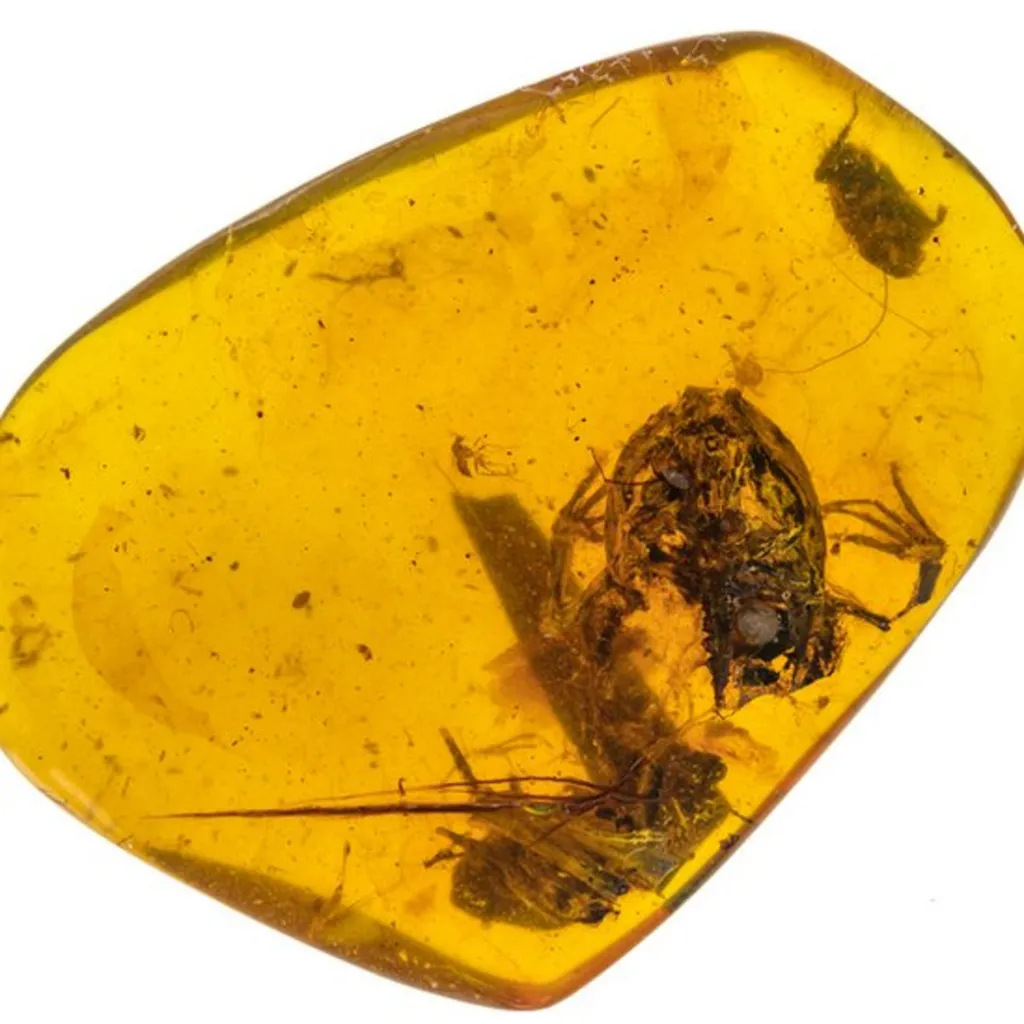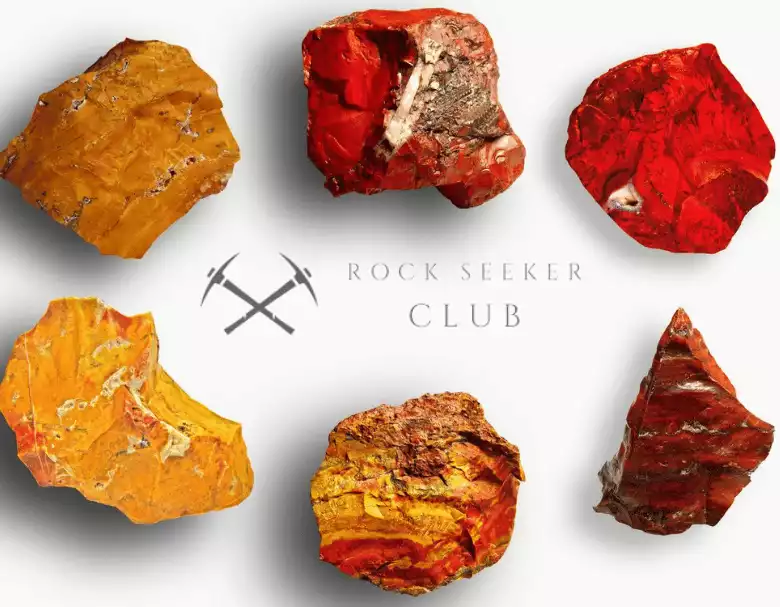Most people know that amber can contain a multitude of different objects. The prehistoric, polymerized resin of ancient trees often trapped small insects and plant debris when released.
But there’s far more than the occasional fruit fly or tiny beetle that’s been found. From dinosaur tails to ancient predatory scenes, there’s a world of incredible creatures and plants that have been found in the clutches of the warm, orange stone.
Let’s take a look at some of the most fantastic discoveries made, showing us orange-tinted scenes from a prehistoric world trapped in amber!
1. Flowers

While plant matter is very common to find in amber, making up a huge amount of inclusions, it’s rare indeed to find a complete flower. It’s even rarer to find something this large, the included flower is a stunning 1.1” across.
Even odder, this specimen had been largely forgotten, stuffed into the back of the Federal Institute for Geosciences and Natural Resources in Berlin. The specimen had been kept away from the public and was simply filed away under the innocuous label of Specimen X4088.
It turns out that a retired scientist talked about it in passing to a colleague, who promptly inquired about the specimen with the curators. New technology allowed pollen to be extracted from the flower, showing that it’s closely related to the Symplocos flowering shrubs of Asia. The flower is currently designated as Symplocos kowalewskii. It certainly makes one wonder what else might be hiding out there, since such a stunning specimen remained out of view for so long.
2. Dinosaur Tail

One of the newest debates in paleontology relates to how dinosaurs appeared. Long thought to be giant reptiles, it now appears that many of the creatures were more closely related to birds. The idea of feathered dinosaurs is still contested to some degree, but this sample is the first definitive proof that’s shown up.
Encased in this relatively small piece of amber is a segment of tail consisting of eight vertebrae covered in feathers. It’s thought that it belonged to a juvenile specimen of Coelurosaur. This genus of dinosaurs contains a large number of theropods, including such long-running favorites as the Tyrannosaurus species. It’s thought most, if not all, of these animals were feathered.
The paper published on this one is publicly available if your interest runs more than skin deep. Regardless, this extraordinary specimen is definitive proof that at least some species of dinosaur had feathers. It’s also one of the very few soft tissue samples that have remained preserved through the years!
3. Feathers (With Lice!)

Feather samples that are a bit less extraordinary periodically show up in amber. In fact, they were one of the things that had people questioning whether the dinosaurs were indeed feathered instead of the simple, scaled beasts they were often depicted as.
While all feather samples are rather incredible, this particular one shows something further: a lice infestation. The lice remains trapped upon the feather it once dwelt. Previously, the oldest known louse species was estimated at 44 million years old, but this particular sample dates back further to almost 100 million years.
A lot of times it’s the bigger creatures that get all of the attention, but in this case, we have proof that even the dinosaurs had to contend with bloodsucking parasites. This specimen had 10 individual louse nymphs, the individual arthropods measuring only 0.2mm. Almost invisible to the naked eye, the species has been identified as Mesophthirus angeli, and they’re closely related to modern lice.
4. Frogs

In a 99 million-year-old sample of amber, scientists have found the remains of a frog. These samples hail from Myanmar, where four frog and toad species were found encased in the polymerized tree resin.
The fossil evidence for frogs is pretty scarce. We know that amphibians existed, but the small creatures and wet environments in which they thrive aren’t generally known for producing a ton of fossils. These can be considered definitive proof that the diminutive amphibians have been around for as long as we’ve suspected.
The species shows remarkable similarities to modern amphibians like the Fire Bellied Toad. In this case, scientists have decided to name the species Electrorana limoa. Alongside these specimens, other samples found included plants, spiders, and insects. More interestingly, they also found mollusks in these amber samples, giving us more clues as to this ancient, tropical environment.
5. Lizards

Small lizards are sometimes found in amber. As with the frog remains above, these samples are often rotted and don’t show the whole story of the animal’s appearance. This incredible sample, however, shows a stunningly well-preserved gecko. Or at least the front half of one.
This is the only known sample of a species that’s simply called the Yantarogekko. It’s dated to the Eocene era, roughly 56-34 million years ago. While the soft tissue is well preserved, the sample appears to not have a skeleton and the lack of full remains has made it impossible to describe it much further.
What is really interesting is that one of the lizard’s paw pads has been preserved. These show a remarkable similarity to the modern gecko’s sticky pads. These pads give the lizards their famous climbing abilities and consist of rows of thin hair called setae. Not bad for being millions of years old, it’s yet another design that has proven to withstand the passage of time.
6. Mantis

Auctioned for $6,000 in 2016, this is an inch-high specimen of amber. Contained within is a species of mantid with remarkable similarity to modern species. One of the more fascinating species of insect, mantises are found all over the world. If there’s a temperate or tropical climate, there’s likely at least one species running around.
This piece of amber is Dominican in origin. Preserved with remarkable clarity, the stone is thought to hail from the Oligocene era. That makes it one of the newer samples we’ve listed here, dating “only” to 23-34 million years ago.
Unfortunately, I was unable to find any actual studies done on the mantis itself. It was sold privately and remains in private hands, but Heritage Auctions is a reputable auction house and is not known to deal with fraudulent samples. Mantis fossils have been found that are much older, around 135 million years, but these tend to hail from Siberia while this remarkable specimen hails from South America.
7. Spider and Wasp

One hundred million years ago, a juvenile spider caught a male wasp in its web. As it moved in for the killing and eating portion of its day, it got covered in sap along with its prey. The spider mere millimeters from its meal, and the wasp is eternally stuck in the position of being prey. So it goes.
While neither of these animals is common in amber, finding them in such a scene is incredibly rare. As far as I know, this is the only known sample of arthropod predation that’s been captured in such exquisite detail. This sample hails from Myanmar.
Interestingly, both of these arthropods are fairly well known. The spider species is Geratonephila burmanica, a species of social orb weaver spiders that group together and spin webs. The wasp species is Cascoscelio incassus, a species of wasp. Both are extinct, but this exquisite scene remains as a stunning, almost living sample of Earth’s history.
8. Scorpions

Despite what Etsy and eBay would have you think, scorpions in amber are incredibly rare finds. Those found for sale are almost invariably fake, just modern resin surrounding a modern scorpion. However, these inclusions do occur in both Myanmar and Baltic amber on occasion.
The scorpion pictured above is the species Palaeolychas balticus, and measures in at only 13mm. This well-preserved specimen shows all of the features we associate with these arachnids. While the venom hasn’t remained intact, it was likely a rather fierce species for its size.
When examining scorpions the clue is in their claws. Less venomous species, like the Emperor Scorpion, often have very strong claws for tearing apart prey. On the other hand, species like the Deathstalker generally have long thin claws similar to the above specimen.
If you’re further interested in prehistoric scorpions, you can take a look at this article which details all known scorpion samples in Baltic amber from 1996 onwards.
- Online rock and mineral club for collectors of all levels!
- Find community with like-minded rock and mineral enthusiasts.
- Monthly Giveaways!
- Free Access to Entire Digital Library of Products (annual memberships)


